UPSC GS 1
Amazon River
- News: Amazon River basin is facing an extraordinary drought, with water levels dropping to historic lows throughout the region.
- Amazon River:
-
- The Amazon River is the world’s largest river by water volume and width, and it is the second-longest river in the world after the Nile.
- It spans about two-fifths of the South American continent.
-
- Course: The river begins its journey in the Andes Mountains and flows into the Atlantic Ocean along the northeastern coast of Brazil.
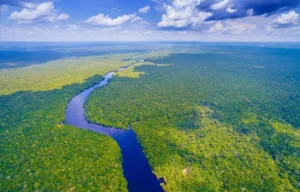
- River Basin:
-
- The Amazon River has the largest drainage basin of any river system.
- Its watershed spans across Brazil, Peru, Ecuador, Colombia, Venezuela, and Bolivia.
- Approximately two-thirds of the Amazon’s main stream and the largest portion of its basin lie within Brazil.
-
- Seasonal Changes:
-
- The river’s width varies with the seasons.
- During the dry season, it spans 4 to 5 km, while in the wet season, it can expand to 50 km.
-
- Tributaries: Some of the most notable tributaries include the Rio Negro, the Madeira River, and the Xingu River.
- Amazon Rainforest:
-
- The Amazon Rainforest, which surrounds the river, represents about half of the Earth’s remaining rainforest and is the largest reserve of biological resources.
- Often called the “lungs of the Earth,” the Amazon plays a crucial role in regulating the planet’s oxygen and carbon cycles.
-
Read also: Understanding Lateral Entry in Civil Services | UPSC
Mali
- News: More than 70 people have been killed in an attack by an al-Qaeda-linked group on Mali’s capital Bamako recently.
- Definition: Mali is a landlocked country in West Africa, covering an area of 1,240,192 sq. km, with its capital in Bamako.
- Bordering Countries: Mali shares borders with seven nations: Burkina Faso, Niger, Senegal, Guinea, Cote d’Ivoire, Algeria, and Mauritania.
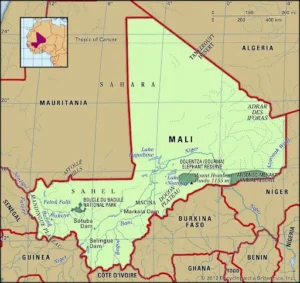
- Geography:
-
- Approximately 65% of Mali is desert or semi-desert, with the Sahara Desert occupying much of the northern region.
- The landscape transitions from the Sahara in the north through the Sahel to Sudanian savanna in the south.
- Mali is one of the hottest countries globally, with summer temperatures averaging 46°C (114.8°F).
- The Niger River flows through the interior, serving as the main water source for the population, which is concentrated along the river.
-
- Population & Ethnic Groups: Despite its large size, Mali has a relatively small population. The largest ethnic group is the Bambara, making up 36.5% of the population.
- History & Languages:
-
- Mali gained independence from France in 1960.
- Languages spoken include Bambara (the most widely spoken), Dogon, Fulfulde, Manding, Arabic, Tuareg, and French.
-
- Economy:
-
- Mali’s economy is primarily based on agriculture, with cotton as its largest crop export.
- The country is also the third-largest gold exporter in Africa.
-
UPSC GS 2
Vivad Se Vishwas Scheme 2024 (VSV 2.0)
- News: The Central Government has notified October 1 2024 as the starting date for direct tax dispute resolution scheme Vivad Se Vishwas 2.0.
- Vivad Se Vishwas Scheme 2024 (VSV 2.0):
- Definition: The scheme is designed to reduce ongoing income tax-related litigations, providing a streamlined process for taxpayers and the Income Tax Department to resolve disputes.
- Primary Goal: VSV 2.0 aims to provide a cost-effective solution for settling disputed tax issues, reducing litigation burdens on taxpayers and the judicial system.
- Appeals Mechanism:
-
- VSV 2.0 offers a mechanism for filing appeals across various forums, including the Joint Commissioner of Income-tax (Appeals), Income Tax Appellate Tribunal (ITAT), and higher courts.
- The scheme states if a taxpayer has a direct tax appeal pending before a commissioner, tribunal, high court, or Supreme Court, they can choose not to litigate and instead settle the appeal by paying the full tax amount, thereby waiving any interest and penalties. This applies to cases where the taxpayer has filed an appeal.
-
- Coverage:
-
- The scheme covers appeals, writ petitions, and special leave petitions pending as of July 22, 2024.
- It waives penalties and interest on settlements, ensuring no prosecution for cases resolved under the scheme.
-
- Additional Coverage:
-
- It also applies to cases with objections filed before the Dispute Resolution Panel (DRP) where no final assessment order has been issued, and pending revision applications before the Commissioner.
-
- Exclusions: Cases involving searches, prosecutions, undisclosed foreign income, and taxpayers under specific legal restrictions or serious offenses are excluded from eligibility.
Financial Action Task Force (FATF)
- News: The Financial Action Task Force (FATF) has opined that Indian agencies have seized significant amounts from proscribed terrorists under the Unlawful Activities (Prevention) Act, and assets from terror financing (TF) and money laundering (ML) investigations.
- Definition:
-
- FATF is an inter-governmental body that has developed standards to prevent and combat money laundering and terror financing.
- It was established in 1989 during the G7 Summit in Paris to develop policies against money laundering.
-
- Objective:
-
- To establish international standards, and to develop and promote policies, both at national and international levels, to combat money laundering and the financing of terrorism.
- In 2001 its mandate expanded to include terrorism financing.
-
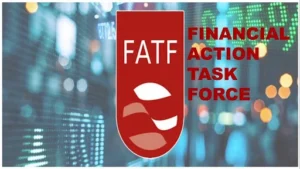
- Members:
-
- FATF members include 39 countries, including the United States, India, China, Saudi Arabia, UK, Germany, France, Britain.
- India became a member of FATF in 2010.
-
- Headquarters: Paris, France.
- FATF Lists:
-
- Black List: Countries known as Non-Cooperative Countries or Territories (NCCTs) are put on the blacklist. These countries support terror funding and money laundering activities. The FATF revises the blacklist regularly, adding or deleting entries.
- Three countries North Korea, Iran, and Myanmar are currently in FATF’s blacklist.
- Grey List: Countries that are considered a safe haven for supporting terror funding and money laundering are put on the FATF grey list. This inclusion serves as a warning to the country that it may enter the blacklist.
-
- Effects of being on the FATF Blacklist:
-
- No financial help is given to them by the International Monetary Fund (IMF), the World Bank, the Asian Development Bank (ADB) and the European Union (EU).
- They also face a number of international economic and financial restrictions and sanctions.
-
UPSC GS 3
White Revolution 2.0
- News: Recently, the Union Home and Cooperation Minister Amit Shah announced plans for “White Revolution 2.0”.
- White Revolution:
-
- The White Revolution, or Operation Flood, launched on January 13, 1970, was the world’s largest dairy development programme and a landmark project of India’s National Dairy Development Board (NDDB).
- It transformed India from a milk-deficient nation into the world’s largest milk producer, surpassing the USA in 1998, with about 17% of global output in 2010-11 .
- It gave rise to AMUL, an Indian dairy cooperative.
- Verghese Kurien is called ‘the milkman of India’, and the ‘Father of the White Revolution’. He was the founding chairperson of National Dairy Development Board (NDDB).
-
- White Revolution 2.0
- Definition:
-
- The Central Government has unveiled ‘White Revolution 2.0’, a comprehensive initiative aimed at empowering women farmers and creating job opportunities.
- The programme is one of the three initiatives undertaken in the first 100 days of the Modi government’s third term.
-
- Funding:
-
- Initially, the National Dairy Development Board (NDDB) will fund the initiative from its own resources, providing Rs 40,000 per M-PACS to 1,000 M-PACS.
- The bulk of the funding later on will come through the National Programme for Dairy Development (NPDD) 2.0, a new central sector scheme under the Department of Animal Husbandry and Dairying.
-
- Focus Areas: The programme focuses on four key areas:
-
- Empowering women farmers,
- Enhancing local milk production,
- Strengthening dairy infrastructure, and
- Boosting dairy exports.
-
- Key Features:
-
- The government aims to increase milk procurement by dairy cooperative societies by 50 % over the next five years.
- Setting up and strengthening 100,000 new and existing district cooperative societies, multi-purpose district cooperative societies, and multi-purpose PACS, which will be linked to milk routes with necessary infrastructure.
- Providing enabling infrastructure e.g. AMCU (Automatic Milk Collection Unit), DPMCU (Data Processing Milk Collection Units), testing equipment, Bulk Milk Coolers, etc., will be the key component of the initiative for carrying out dairy activities.
-
- Dairy Industry in India:
-
- India is the highest milk producer and ranks first position in the world contributing 25% of global milk production.
- The milk production of India has registered 58% increase during the last 9 years i.e., during the year 2014-15 and 2022-23 and increased to 230.58 Mn Tonnes in the year 2022-23.
- The top 5 milk-producing states are: Rajasthan , Uttar Pradesh, Madhya Pradesh, Gujarat and Andhra Pradesh. They together contribute 53.11% of total Milk production in the country.
- India’s Export of Dairy products was 63,738.47 MT to the world for the worth $272.64 Mn during the year 2023-24.
- Major Export Destinations (2023-24): United Arab Emirates, Saudi Arab, USA, Singapore, and Bhutan.
-
- World Milk Day: June 1
Radio Astronomy
- News: Elon Musk’s Starlink satellites are disrupting astronomers’ work by causing unintended electromagnetic radiation, or “radio noise,” that interferes with Earth-based radio observations.
- What is Radio Astronomy?
-
- It is a branch of astronomy that studies celestial objects at radio frequencies.
-
- Radio Waves:
-
- All matter is made of atoms, which consist of electrons orbiting a nucleus of protons and neutrons.
- When charged particles like electrons and protons accelerate, they emit electromagnetic radiation.
- This radiation forms the electromagnetic spectrum, with the longest wavelength and lowest energy being radio waves.
-
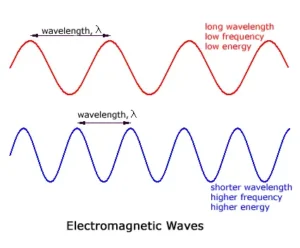
-
-
- Visible light is energetic enough to help plants produce their own food through photosynthesis. Radio waves are far weaker than this so we need electronic amplifiers to help us boost their signal.
- Any electromagnetic wave with a wavelength greater than 1 mm is a radio wave.
- Radio waves, the basis of radio astronomy, are what radios use to transmit into people’s homes across the globe.
- Radio waves were first detected from space in the 1930s but few scientists took the discovery seriously. The development of radar in the Second World War led to improvements in antennas and electronics.
-
- Radio Telescope: A radio telescope is simply a telescope that is designed to receive radio waves from space. Unlike optical telescopes that detect visible light, radio telescopes are designed to detect radio waves (which have higher wavelengths and lower frequencies) emitted by objects in space.
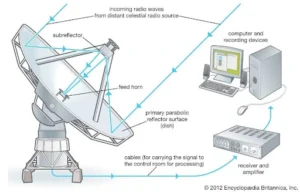
Read also: Ethanol Blending in India: Challenges and Opportunities | UPSC
Kleptoparasitism
- News: Researchers suggest that kleptoparasitism, or food theft among seabirds, could be a transmission pathway for the H5N1 avian influenza virus, potentially explaining its rapid global spread.
- About Kleptoparasitism:
-
- Kleptoparasitism refers to the act of stealing food or other resources collected or prepared by another animal.
- It occurs in various animal groups, including birds, insects, and mammals, and is a form of social parasitism.
-
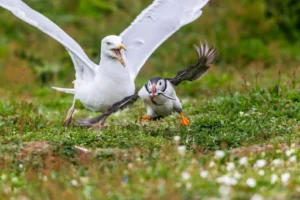
- Forms of Kleptoparasitism:
-
- Animals may steal prey, stored food, or even nest materials from others.
- This behavior allows the kleptoparasite to benefit from others’ efforts without expending energy on searching or capturing resources.
-
- Types:
-
-
- Kleptoparasitism can be intraspecific (within the same species) or interspecific (between different species).
- In interspecific cases, the parasites are often close relatives of their hosts, as suggested by “Emery’s Rule.”
-

